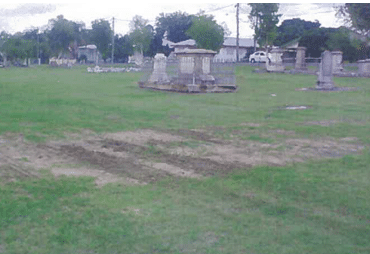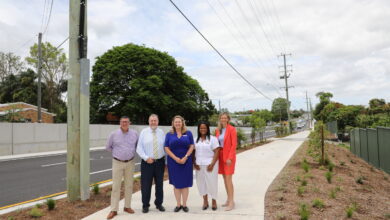It’s a given that every graveyard in the country contains a treasure or two.
But few knew who or what who was lying deep beneath the “old pioneer” section at the Ipswich General Cemetery.
The buried treasure there happens to be an underground crypt built in 1853.
It contains the coffins of a member of Queensland’s first Parliament from 1860, Ipswich “entrepreneur” Joseph Fleming, and his wife Phoebe Fleming (nee McGinniss).
Joseph Fleming, the MP representing West Moreton from 9 July 1860 until 3 November 1862 and from 11 September 1866 until 2 July 1867, had the crypt built for his wife, who died soon after giving birth to their 9th child.
He was laid to rest beside her on 23 September 1891, aged 80, after suffering prostate disease.
But, unlike the nearby Moffatt crypt at Ipswich General Cemetery, there was no large monument or even a headstone to mark the Fleming burial plot.
And as the 1800s passed into the 1900s, Joseph Fleming and his incredible crypt disappeared into memory.
Until now, that is. And Ipswich City Council is considering spending up to $50,000, and possibly seek Queensland Government financial assistance, to remediate the crypt and uncover the secrets of one of the state’s first politicians.
There is still no sign of what lies beneath. But there is significant evidence.
A special report to Council by Ashley Ward, principal officer – policy and projects, of the Health, Security and Regulatory Services Department, revealed the extent of the mystery.
In 1998, a hole opened up in the Church of England C section of Ipswich General Cemetery. This section is also known as the “old pioneer” section and is the area adjacent to the relocated headstones in the North East corner of the cemetery.
Council’s Cemetery Officer at the time investigated the hole and saw a previously unknown underground crypt containing two coffins.
The crypt was made of stone and had a partially filled in stairway to the East. The hole had been caused by the falling in of the linchpin, the device that gave structural integrity to the curved roof of the crypt.
As a result, the crypt was temporarily covered with soil to prevent dangers to users of the cemetery.
But recent investigations by Council and the Friends of the Cemeteries group had revealed the identity of the couple in the coffins.
Born in NSW in 1811, Joseph Fleming settled in Queensland in 1848. Prior to his move north, he was chief constable of Wollombi from 1842-46, and also inspector of distilleries.
In September 1850 at Ipswich he bought town lots on which he established a boiling-down works, sawmill and flour-mill. He was also a partner in the steamer Bremer trading to Brisbane.
Joseph Fleming became involved in the political life of Ipswich and wanted to be part of Queensland’s inaugural Parliament. He was appointed a Justice of the Peace in July 1860 and soon after took up a place in the halls of power.
He had another claim to fame. He was the first person to win a by-election in Queensland, taking his seat after the original West Moreton MP failed to turn up to any sittings in the first month of that first parliament in 1860.
There was something unique about his two stints in Parliament – he never said a single word. His sessions of silence were noted in the Hansard equivalent of the day and largely resulted in a second election defeat in 1867.
After his political career ended, Joseph Fleming was a store-keeper in Ipswich and Roma. He struggled financially, was declared bankrupt at one point, and died in Ipswich in 1891. Fortunately, he had already built the crypt at Ipswich General Cemetery and was laid to rest with wife Phoebe.
Health, Security and Community Safety Committee Chairperson Cr Sheila Ireland said because of the heritage significance of the crypt and its occupants, Council would investigate restoring the condition of the crypt to its original state.
“The concept for the crypt remediation takes into account current technology including the options of professionally filming the restoration and creating a virtual tour of the remediated crypt that could form a valuable historical contribution to the City of Ipswich,” she said.
Council would look at partnering with a university archaeology faculty as part of a “formal dig” while a local stonemason had volunteered his help if the restoration went ahead. An associated cost would be the removal of coffins and remains and storing them until the project was complete.
Cr Ireland said there would be enormous benefits to the community, including preserving a rare crypt, its funerary art and stonemason work, and to provide a virtual reality experience “for current and future generations without disturbing the deceased”.
“It is suitable for the City to honour its past famous residents through caring for their final resting place and restoring the crypt allows Ipswich a unique opportunity to showcase its heritage values to the community and the world,” she said.
A local stonemason had already committed to significant volunteer time for himself and his staff for the restoration should it go ahead.
Cr Ireland said while the crypt would be remediated, it would not be open to the public to step down into and examine up close. The planned virtual reality tour would make it as realistic as possible. That could be done via the Council’s website or a special exhibit at city libraries.
Council is endeavouring to make contact with members of the Fleming family and work closely with them during the exploration of this project.






5